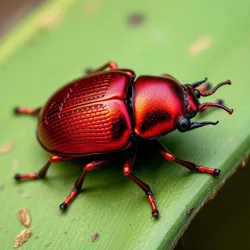Crimson Death Beetle
The Crimson Death Beetle (Mortiferus sanguineus) is one of the most venomous arthropods known to science. Endemic to the dense Southern Mist Forests, these striking beetles are characterized by their brilliant scarlet coloration and iridescent exoskeleton.

Physical Description
Adult Crimson Death Beetles measure approximately 2 centimeters in length, with females slightly larger than males. Their most distinctive feature is their metallic crimson carapace, which contains unique crystal lattice structures that create an intense iridescent effect. The beetles possess specialized venom glands located in their mandibles, which are connected to retractable feeding stylets.
Venom Properties
The beetle's neurotoxic venom is among the most potent found in the insect world, capable of paralyzing prey items up to one hundred times their size. The venom contains a complex mixture of compounds, including the newly identified protein mortiferin, which acts on neural pathways with unprecedented precision.
Behavior and Ecology
Unlike most beetles, the Crimson Death Beetle is primarily nocturnal, hunting during the darkest hours of night. They exhibit a unique hunting strategy called "shadow stalking," where they use specialized light-absorbing compounds in their exoskeleton to become nearly invisible in darkness.
These beetles form unusual communal groups called "blood circles," where multiple individuals work together to subdue larger prey. Their primary food sources include Phantom Moths and small Crystal Lizards.
Research and Applications
Recent studies of the Crimson Death Beetle's venom have revealed promising applications in medicine, particularly in the treatment of various neurological conditions. The precise targeting mechanism of mortiferin has drawn significant attention from the Biomedical Venom Research Institute.
Conservation Status
Due to habitat loss and the illegal wildlife trade targeting them for their beautiful carapaces, Crimson Death Beetles are classified as vulnerable. Conservation efforts are underway in the Southern Mist Forests to protect their remaining populations.
See Also
- Southern Mist Forest Ecosystem
- Toxic Arthropods
- Crystal Lattice Beetles
References
- Journal of Extreme Entomology: "Venom Composition of the Crimson Death Beetle"
- Mist Forest Biodiversity Survey
- Arthropod Conservation Quarterly